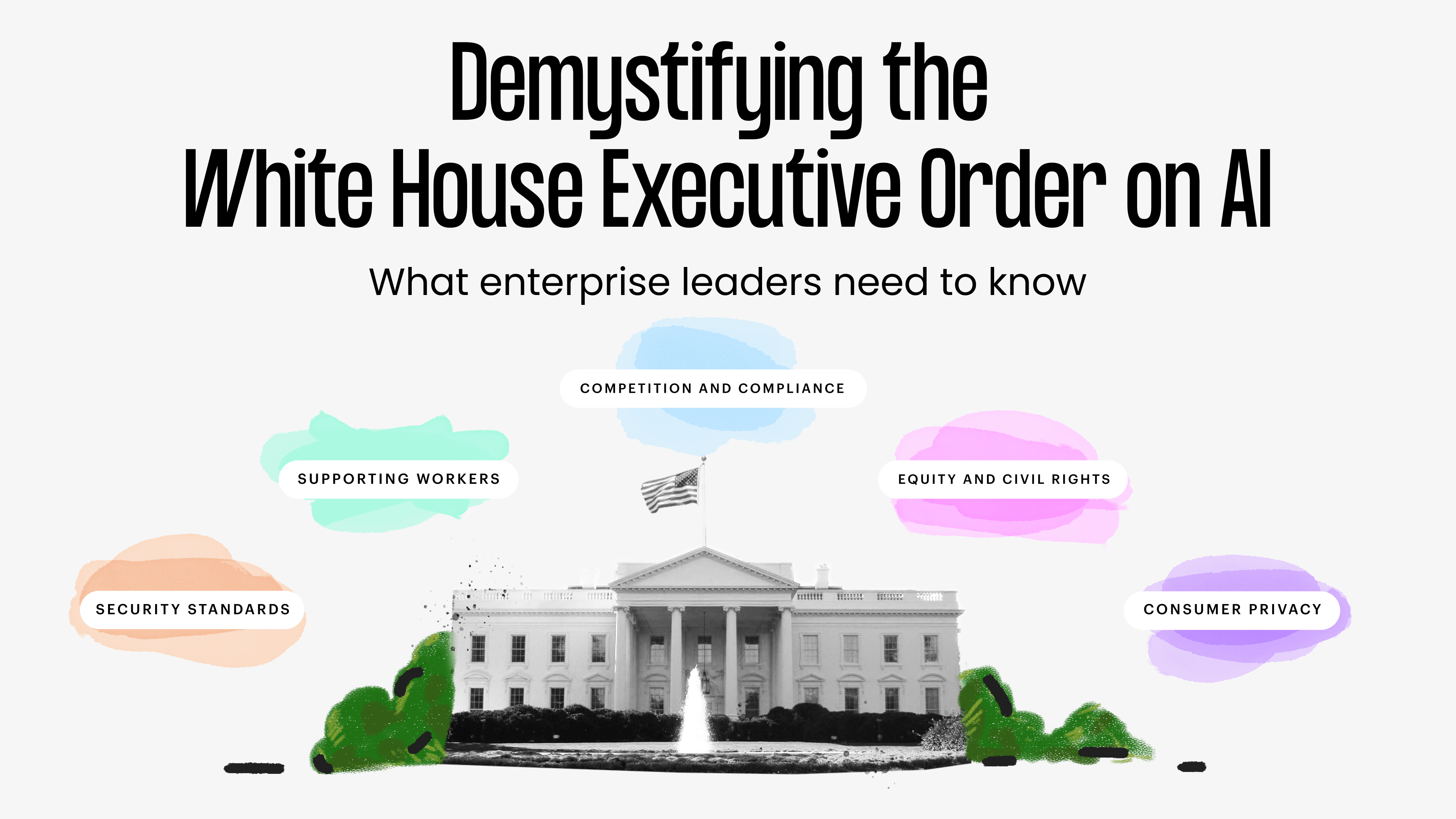AI in the enterprise
– 10 min read
Learn the basics: What is machine learning?

We all know that staying ahead in the digital race is important. Organizations that don’t prioritize digital innovation leave themselves vulnerable to losses. But with the opportunity of new technologies comes a significant amount of risk: potential security vulnerabilities, a disconnection from strategic objectives, and wasted time.
A solid understanding of machine learning (ML) will allow leaders to make smarter decisions about generative AI implementation. It’ll help them distinguish opportunities from hype, mitigate risks, evaluate different solutions or vendors, and collaborate with tech teams effectively.
This post aims to equip you with the knowledge to introduce machine learning successfully in your organization.
- ML is a powerful subtype of artificial intelligence where computers to learn from data without explicit programming.
- There are three main types of ML: supervised learning, unsupervised learning, and semi-supervised learning.
- Machine learning is increasingly important for companies because it can help them predict trends, understand customer behavior, and spot business patterns.
- Machine learning is used for many applications, such as customer understanding, identifying patterns and trends, and understanding customer activity.
- When using machine learning, keep in mind data predicting accuracy, bias in data patterns, and the black-box dilemma.
What is machine learning?
Machine Learning (ML) is one subtype of artificial intelligence (AI). In ML, computers learn from patterns in data to complete tasks without being explicitly programmed.
Have a look at this set of numbers: one, two, three, four.
What would you say if I asked you to predict the next number? You’ll likely have identified the pattern of increasing the number by one. So you’d say: five.
It’s the same premise for machine learning, though on a much larger scale.
Instead of a simple number sequence, imagine a data set showing the number of orders in a global ecommerce store over many months. Based on the patterns in that data set — which might be too complicated for a human to spot — an ML system can make an informed guess about how many orders the company can expect on any given day in the future. Generally, the larger the data set (think, five years worth of sales history vs. five months), the more accurate the guess will be.
Software equipped with machine learning gives companies predictive power. Instead of making decisions on past data, organizations can see how their customers are likely to behave and adjust their strategies accordingly. It can be used for many different applications, such as credit scoring, fraud detection, and medical diagnosis.
Are machine learning and generative AI the same thing?
Artificial intelligence (AI) is the broad concept of a machine or system that can perform tasks like a human in some way. Machine learning is just one subtype of AI where computer systems learn and improve from experience without being explicitly programmed. It’s like teaching a computer to learn on its own, just like humans do.
Generative AI is a type of machine learning that uses algorithms to generate output from a given set of input data. It’s different from other types of machine learning in that it doesn’t simply recognize patterns, but instead creates new content based on the data that’s input. Generative AI is used in many applications such as natural language processing, image generation, music composition, and recommendation engines.

Check out our guide: Generative AI explained
How does machine learning work?
Machine learning systems learn and improve themselves based on data sets.
Training machine learning systems involves feeding the computer, also known as a model, with a substantial amount of data related to a specific task. The model then analyzes the data, searching for patterns and relationships.
During the training phase, the model adjusts its internal parameters to make accurate predictions or classifications by comparing its results to known correct answers from the provided data. The process is iterative: developers fine-tune the model’s parameters until it achieves satisfactory performance on new, unseen data.
Imagine you want to build an application that can automatically identify whether a picture contains a cat or a dog. To do this, you’d collect a large dataset of labeled images — some with cats and some with dogs.
The machine learning model starts by analyzing these images, looking for patterns or features that can help distinguish between cats and dogs. It might notice that cats often have pointy ears and slanted eyes, while dogs have floppy ears and rounder eyes. Then, the model keeps tweaking its algorithms until it becomes better and better at making accurate predictions.
With enough training and data, the model can achieve a high level of accuracy in identifying cats and dogs when there are no labels and even if they are in different poses or lighting conditions.
What are the three types of machine learning?
Within ML, there are three main types.
- Supervised learning involves feeding the algorithm-labeled training data with known results or outcomes which it uses to create predictive models.
- Unsupervised learning requires no labeled data but relies on the algorithm’s ability to detect patterns within the dataset.
- Semi-supervised learning combines elements from both supervised and unsupervised methods. This means, some data might be labeled, but the model is free to explore data and develop its own patterns.
Why is machine learning increasingly important for companies?
It’s no wonder that ML and AI technologies are growing and trying to fill sore spots for enterprises. Especially since reduced cost and automation, new business applications, and increased tech access are the three main drivers for AI adoption.
Senior leaders see a lot of promise in generative AI, which is a subset of machine learning. The top benefits they cite are employee productivity, higher-quality output, and cost savings.
The power to predict trends, understand customer behavior, and spot business patterns empowers companies to make informed decisions that improve profit and growth. Machine learning can also help enforce company rules and industry regulations by detecting instances of non-compliance, thus protecting your company from legal or reputational risks.
What’s machine learning used for in business?
Thanks to ML’s ability to identify patterns and make predictions, it offers many advantages to businesses. Companies across a range of industries can use machine learning to support various operations.
Identify market patterns and trends
ML can quickly identify market and customer behavior patterns. It allows businesses in all industries to be agile and adapt to shifting markets.
Optimize advertising campaigns
ML algorithms can identify the most relevant audience segments, optimize ad placements, and even predict the best times to display ads, resulting in higher conversion rates and ROI.
Personalize the customer experience
Companies can offer tailored product suggestions and custom content based on customer behavior.
Understand customers faster
ML-powered natural language processing enables companies to analyze and understand vast amounts of unstructured text data, such as customer feedback, social media posts, and product reviews. These insights can be used for sentiment analysis, market research, and improving customer support.
Scale up content production
Generative AI systems (powered by ML) can be used to support content teams, allowing them to write content more efficiently.
Enforce rules and guidelines
Machine learning can be used to scan documents for compliance with legal, regulatory, and brand standards. This could include scanning for specific keywords or phrases, analytics to detect patterns, and even natural language processing to identify problematic language. For example, Intuit uses the Writer generative AI platform to enforce their content design system in Figma and Google Docs and check content in Slack for inclusivity.
Detect fraudulent activity
Machine learning algorithms can detect fraudulent activity, allowing banks to accurately differentiate between legitimate and suspicious transactions with minimal manual effort or intervention from staff members. For example, Paypal uses ML to identify buying behavior patterns and trends in their users. By doing so, ML can alert the PayPal team when a purchase pattern is unusual and could be a fraud.
Make accurate diagnoses
By analyzing patient data such as symptoms, lab results, and medical images, ML-powered systems can achieve higher accuracy in diagnosis and speed up medical research. For example, a medical study used ML to predict how patients would react to drugs for a central nervous system clinical trial.
Machine learning considerations to keep in mind
ML is a groundbreaking tool for businesses to provide better services, improve their market strategies, and learn from customers. But it’s important to keep in mind the considerations related to machine learning. This will help you choose the best model and tool depending on your company’s needs.
Data predicts accuracy
The accuracy of ML models has a correlation with the amount of data in the system. This makes sense, of course, but there’s a question of ethics in accuracy.
For ML to be accurate, it requires a lot of data. For example, for credit-scoring, the improvement of predictions and accuracy comes at the expense of large amounts of individual personal data.
On the other hand, ML has difficulty analyzing the nuances and context of situations that require human judgment for high accuracy.

Learn more: Why you can’t replace human insight: The importance of editorial skills in the AI era
Bias in data patterns
The data used for machine learning can be filled with bias. This means that the quality and patterns of data used to train a machine follow patterns of bias. In turn, this leads to biased predictions and forecasts.
This is particularly problematic when negative prediction outcomes affect those who are already marginalized and underrepresented. The bias can also come from data that’s underrepresented, aggregated, and omitted.

Learn more: Tackling AI bias
Black-box dilemma
Although a programmer or data scientist feeds the machine data, most models aren’t able to explain the reasons they produce the outputs they do. This can make it challenging to rectify bias and find failures in the model.
As adoption of these AI technologies expands, the necessity for transparency and accountability becomes critical. Recently, the White House issued an Executive Order that focuses on creating criteria, tools, and assessments to make sure AI systems are secure, reliable, and trustworthy. Writer addresses these concerns by employing a multi-tiered approach that leverages cutting-edge algorithms and technologies.

Learn more: Demystifying the White House Executive Order on AI
Find the right innovation partner
It’s clear that machine learning is disrupting and improving the efficiency of business activity. If you want to be competitive, you need to support your team with the right technology.
But not all ML tools are equal or applicable to each business use case. Leaders must choose technology partners that can scale as their company grows, keep data secure, and adapt to their business needs.
Interested in incorporating the power of ML and generative AI into your organization? Learn how Palmyra LLMs can support your business growth.





